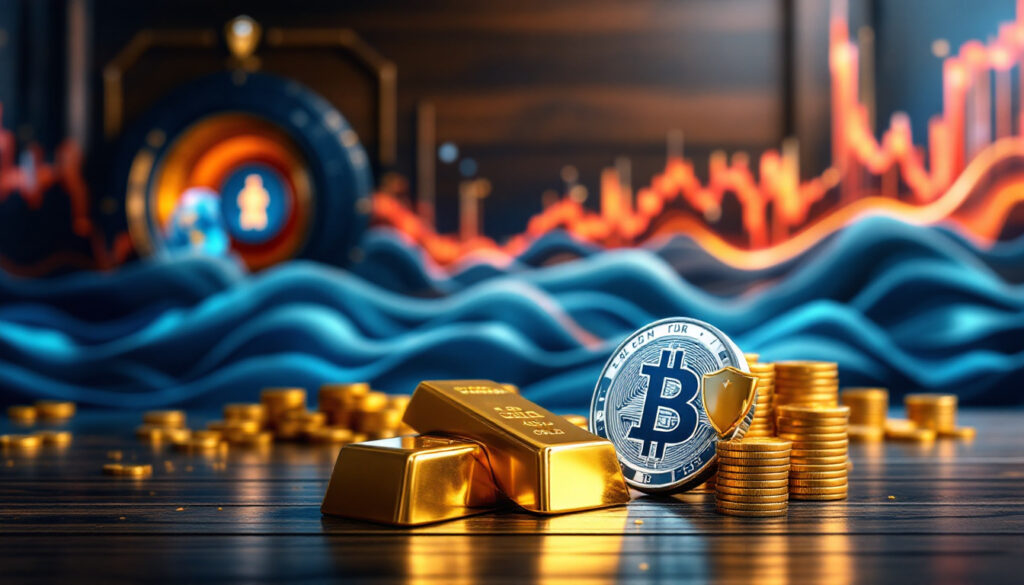Gold and Silver Investment Opportunities: A Complete Guide
Gold and silver have historically served as safe-haven assets during economic uncertainty, offering inherent value that fiat currencies lack. Recent market trends highlight gold's resilience, recovering 3% losses within five business days to hit new all-time highs amid geopolitical tensions. Central banks and institutional investors are increasingly prioritizing precious metals, driven by concerns over currency devaluation and trade fragmentation. This report examines the multifaceted role of gold and silver in modern portfolios, analyzing gold market analysis, central bank strategies, and practical considerations for investors.
Why Invest in Gold and Silver in Today's Economy?
The Fundamental Value Proposition of Precious Metals
Gold and silver maintain intrinsic value independent of currency fluctuations, functioning as globally recognized stores of wealth. Unlike fiat currencies, which central banks can devalue through quantitative easing, precious metals offer finite supply and historical stability. For instance, all gold ever mined remains in circulation, whereas approximately 50% of silver is industrially consumed and irrecoverable. This scarcity underpins their role as portfolio diversifiers, mitigating volatility in equity markets. Quantitative data reveals that gold as a hedge has outperformed major stock indices during recessions, with a 25% average annual return during the 2008 financial crisis compared to the S&P 500's -37% decline.
Andrew Slay, a seasoned investment expert, emphasizes that gold's recovery of 3% losses within five days during recent trade disputes exemplifies its liquidity and demand during crises. Such resilience is critical for investors seeking to preserve capital amid inflationary pressures, particularly as global debt levels exceed 330% of GDP.
How Are Trade Wars Impacting Gold and Silver Prices?
Key Market Reactions to Trade Tensions
The U.S.-China trade war has intensified demand for gold, with prices rebounding sharply after short-term dips. Silver, while lagging gold's momentum, demonstrates gradual appreciation due to its dual role as a monetary and industrial metal. Geopolitical uncertainty drives capital flight from equities to precious metals, as evidenced by institutional investors reducing exposure to overvalued U.S. stocks. For example, Market Watch reported unprecedented pessimism among fund managers, with 68% anticipating a market correction within 12 months.
Slay notes that trade restrictions on rare earth metals exacerbate supply chain disruptions, indirectly bolstering silver's industrial demand. China's potential export curbs on critical minerals threaten sectors like renewable energy, where silver constitutes 15% of photovoltaic cell composition. Such dynamics highlight silver's unique position as both a hedge and a consumption-driven asset.
What's Happening with Central Bank Gold Purchases?
Notable Central Bank Activities
Central banks are acquiring gold at record rates, diversifying reserves away from U.S. Treasuries. Uzbekistan added 8 tons in January 2025, while Poland's 20-ton purchase surpassed its cumulative acquisitions over five decades. This trend, initiated pre-trade wars, reflects strategic preparations for potential currency resets. Bullion banks are similarly accumulating physical metals, with global gold reserves growing by 1,136 tons in 2024 alone.
China's central bank, a leader in de-dollarization efforts, has offloaded $200 billion in U.S. debt since 2022 to bolster its gold holdings. Such moves align with BRICS nations' initiatives to establish gold-backed trade mechanisms, reducing reliance on the dollar.
How Does Silver Differ from Gold as an Investment?
Silver's Unique Investment Characteristics
Silver's annual demand of 1 billion ounces exceeds production by 200 million ounces, creating structural deficits. Unlike gold, 60% of silver is consumed in industrial applications like electronics and solar panels, rendering it irreplaceable in manufacturing. Slay highlights that silver's conductivity makes it indispensable in technologies like 5G infrastructure, which requires 50% more silver per unit than 4G. This consumption-driven demand, coupled with speculative interest, positions silver for potential price surges during supply crunches.
What Impact Will Interest Rate Policies Have on Precious Metals?
Interest Rate Effects on Precious Metals
Slay warns that zero-percent interest rates could "destroy the U.S. dollar," triggering hyperinflation and capital flight to gold and silver. Lower rates reduce the opportunity cost of holding non-yielding assets, historically correlating with a 15–20% annual rise in gold prices. The Federal Reserve's anticipated $10 trillion liquidity injection into markets may further erode currency values, creating ideal conditions for precious metal appreciation.
How Are Rare Earth Export Restrictions Affecting Commodity Markets?
China's potential restrictions on rare earth exports create significant market uncertainty that indirectly supports precious metals prices. These essential elements, crucial for everything from smartphones to military equipment, represent another flashpoint in ongoing trade tensions. The resulting supply chain disruptions heighten economic anxiety, driving investors toward traditional safe-haven assets.
Market analysts note that rare earth restrictions exemplify broader resource nationalism trends that benefit gold and silver investment opportunities. As countries prioritize domestic resource security, international trade frameworks become increasingly fragmented. This environment typically accelerates precious metal accumulation as nations and individuals seek assets with inherent rather than politically assigned value.
What's Driving Institutional Interest in Precious Metals?
Professional money managers are showing unprecedented pessimism regarding traditional equity markets. Recent surveys indicate many fund managers believe U.S. stocks remain artificially supported through government intervention rather than fundamental economic strength. This disconnect between market valuations and economic reality has pushed institutions to increase precious metals allocations.
Pension funds, sovereign wealth managers, and family offices are quietly building physical gold and silver positions as insurance against potential market corrections. Unlike retail investors who often chase momentum, these sophisticated players tend to accumulate during price dips, creating price support levels. Their methodical approach focuses on long-term wealth preservation rather than short-term speculation.
What Role Do Gold and Silver Play in De-Dollarization?
Gold remains central to global de-dollarization efforts, particularly among BRICS nations seeking monetary independence. The strategic acquisition of gold by central banks represents preparation for a potential international monetary reset. Countries reducing U.S. Treasury holdings in favor of physical gold are effectively voting against dollar hegemony with their reserve decisions.
This trend extends beyond major powers to include smaller nations seeking to protect economic sovereignty. Gold's lack of counterparty risk makes it uniquely positioned as neutral collateral in a fragmented financial landscape. Silver, though secondary to gold in reserve considerations, benefits from the same monetary concerns driving institutional diversification away from fiat currencies.
How Should Investors Approach Gold and Silver Today?
Practical Investment Approach
Investors should emulate institutional strategies by prioritizing physical bullion over paper assets. Slay advises allocating 5–15% of portfolios to gold and silver, adjusting for risk tolerance. Secure storage solutions, such as insured vaults or home safes, are critical to mitigating theft risks. Tax-efficient options like Canadian Maple Leafs or American Eagles offer liquidity and recognition, avoiding numismatic premiums.
In conclusion, market trends in gold and silver remain cornerstone assets for wealth preservation amid monetary debasement and geopolitical instability. By aligning with central bank strategies and prioritizing tangible holdings, investors can navigate impending economic shifts with confidence.
How Can Canadians Protect Their Wealth with Precious Metals?
Canadian investors face unique challenges with national debt levels reportedly reaching 408% of GDP across all sectors. This exceptional liability burden makes the Canadian dollar vulnerable to the same devaluation pressures affecting other fiat currencies. Physical precious metals provide Canadians with protection against both currency risks and potential banking system instabilities.
Canadian tax considerations make certain precious metal investments particularly attractive. For instance, Canadian Maple Leaf coins are considered legal tender, offering potential tax advantages over foreign-minted alternatives. Additionally, allocated storage options through Canadian institutions allow investors to maintain physical ownership while addressing security concerns. As economic uncertainties continue, historical gold and silver trends represent practical protection strategies for Canadian wealth preservation.
FAQs About Gold and Silver Investment
Is gold or silver a better investment right now?
Both metals offer complementary benefits within a diversified portfolio. Gold typically demonstrates greater price stability and leads market movements during economic crises. Silver, with its lower price point and industrial applications, offers potentially higher percentage gains during bullish cycles. Most experts recommend holding both metals, with allocations based on individual risk tolerance and investment horizons.
How much of my portfolio should be in precious metals?
Financial advisors typically suggest 5-15% portfolio allocation to precious metals, though this guideline varies with economic conditions and personal circumstances. During periods of heightened monetary uncertainty or inflation concerns, some experts advocate increasing this allocation to 20-25%. The appropriate percentage depends on your age, existing investments, and financial goals.
What forms of gold and silver are best for investment?
Physical bullion in government-minted coins and bars provides the most direct ownership with minimal premiums. Popular options include Canadian Maple Leafs, American Eagles, Australian Kangaroos, and standard 1-ounce gold or 10-ounce silver bars. Unless you possess specialized knowledge, avoid collectible or numismatic coins with high premiums over metal content. For larger investments, consider allocated storage programs through reputable institutions rather than ETFs that may involve counterparty risks.
How do storage and security concerns impact precious metals investment?
Secure storage represents an essential consideration for physical precious metals. Home safes provide immediate access but carry theft and disaster risks. Bank safety deposit boxes offer improved security but potential accessibility issues during banking crises. Professional storage facilities combining insurance, regular audits, and segregated holdings often represent the optimal solution for substantial investments. Whatever option you choose, maintain proper documentation and consider diversifying storage locations to mitigate geographic risks.
What tax implications should I consider when investing in precious metals?
Tax treatment varies significantly by jurisdiction and investment vehicle. Many regions charge sales tax on silver purchases but exempt gold above certain purity levels. Capital gains considerations apply when selling precious metals at a profit, though some government-minted coins may receive preferential tax treatment as legal tender. Consultation with a tax professional familiar with precious metals investing regulations in your jurisdiction is essential before making substantial investments.
Looking ahead, the gold market outlook 2025 suggests continued strength as global economic uncertainties persist, making strategic allocation to precious metals an important consideration for investors seeking portfolio resilience.
Want to Invest in the Next Major Mineral Discovery?
Capitalise on potentially transformative ASX mineral discoveries with Discovery Alert's proprietary Discovery IQ model, which delivers real-time alerts and turns complex mineral data into actionable insights for both short-term traders and long-term investors. Understand why historic discoveries can generate substantial returns by visiting Discovery Alert's dedicated discoveries page, and begin your 30-day free trial today to position yourself ahead of the market.




